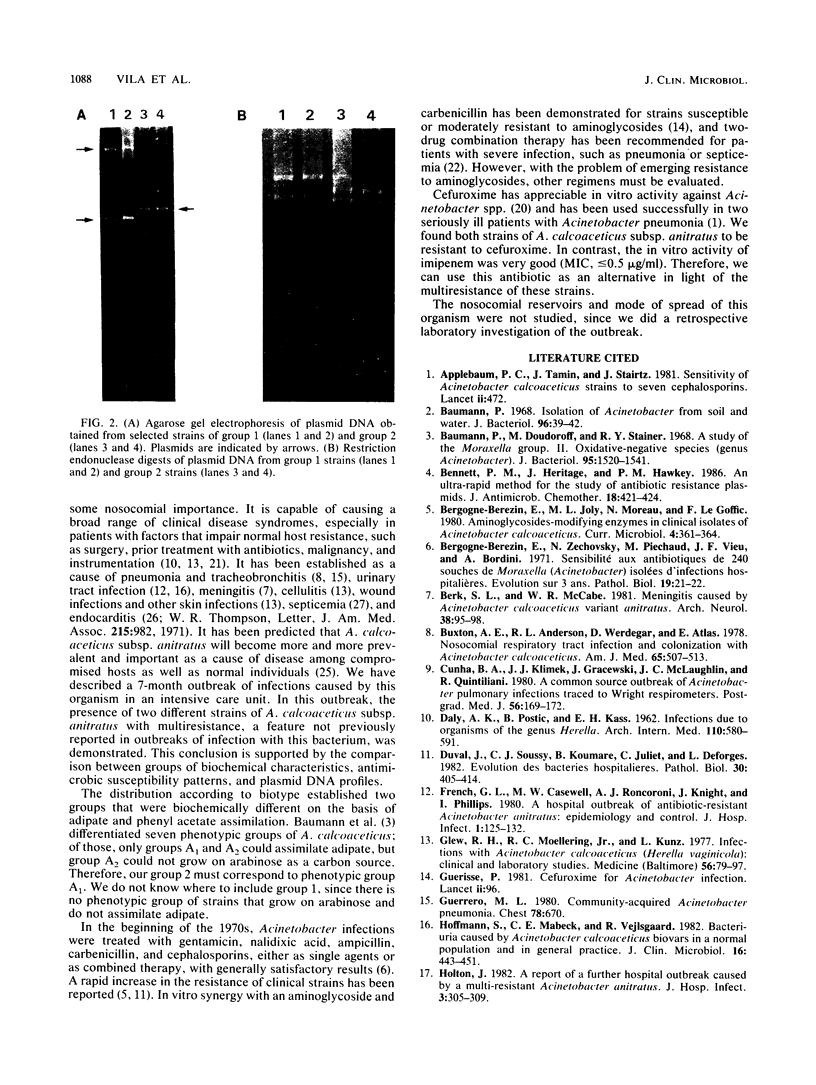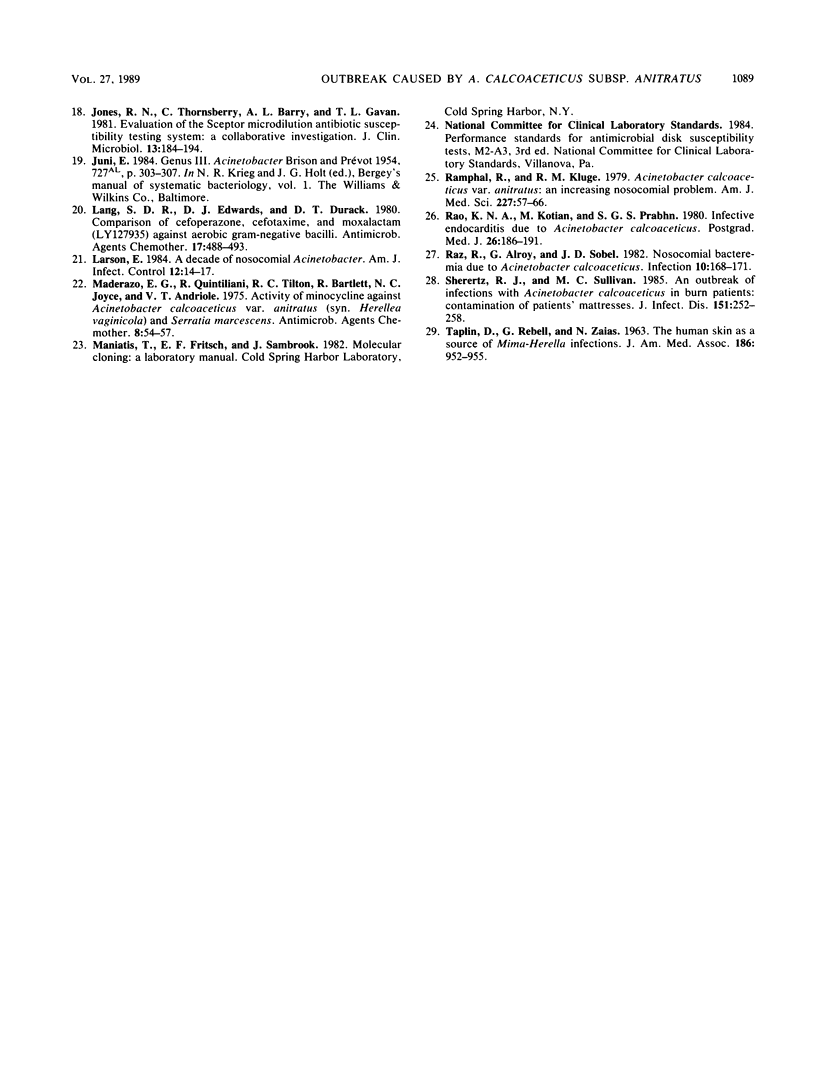Abstract
During a 7-month period, from December 1986 to June 1987, multiresistant strains of Acinetobacter calcoaceticus subsp. anitratus were isolated from 25 patients in a respiratory intensive care unit. The biochemical characteristics defined two groups of strains, group 1 (14 strains) and group 2 (11 strains). Both groups had the same biochemical characteristics, but group 2 strains could assimilate adipate and phenyl acetate. Moreover, of 16 antibiotics tested only netilmicin and imipenem had some inhibitory activity for group 1 strains; group 2 strains were susceptible to mezlocillin, piperacillin, and ticarcillin. Plasmid profiles of the groups were also different. The results of a laboratory investigation (biochemical characteristics, antibiotic susceptibility, and plasmid isolation) identified two different A. calcoaceticus subsp. anitratus strains as the causes of the outbreak.
Full text
PDF



Images in this article
Selected References
These references are in PubMed. This may not be the complete list of references from this article.
- Baumann P., Doudoroff M., Stanier R. Y. A study of the Moraxella group. II. Oxidative-negative species (genus Acinetobacter). J Bacteriol. 1968 May;95(5):1520–1541. doi: 10.1128/jb.95.5.1520-1541.1968. [DOI] [PMC free article] [PubMed] [Google Scholar]
- Baumann P. Isolation of Acinetobacter from soil and water. J Bacteriol. 1968 Jul;96(1):39–42. doi: 10.1128/jb.96.1.39-42.1968. [DOI] [PMC free article] [PubMed] [Google Scholar]
- Bennett P. M., Heritage J., Hawkey P. M. An ultra-rapid method for the study of antibiotic resistance plasmids. J Antimicrob Chemother. 1986 Sep;18(3):421–424. doi: 10.1093/jac/18.3.421. [DOI] [PubMed] [Google Scholar]
- Berk S. L., McCabe W. R. Meningitis caused by Acinetobacter calcoaceticus var anitratus. A specific hazard in neurosurgical patients. Arch Neurol. 1981 Feb;38(2):95–98. doi: 10.1001/archneur.1981.00510020053007. [DOI] [PubMed] [Google Scholar]
- Buxton A. E., Anderson R. L., Werdegar D., Atlas E. Nosocomial respiratory tract infection and colonization with Acinetobacter calcoaceticus. Epidemiologic characteristics. Am J Med. 1978 Sep;65(3):507–513. doi: 10.1016/0002-9343(78)90777-5. [DOI] [PubMed] [Google Scholar]
- Cunha B. A., Klimek J. J., Gracewski J., McLaughlin J. C., Quintiliani R. A common source outbreak of Acinetobacter pulmonary infections traced to Wright respirometers. Postgrad Med J. 1980 Mar;56(653):169–172. doi: 10.1136/pgmj.56.653.169. [DOI] [PMC free article] [PubMed] [Google Scholar]
- DALY A. K., POSTIC B., KASS E. H. Infections due to organisms of the genus Herellea. B5W and B. anitratum. Arch Intern Med. 1962 Nov;110:580–591. doi: 10.1001/archinte.1962.03620230026006. [DOI] [PubMed] [Google Scholar]
- Duval J., Soussy C. J., Koumare B., Juliet C., Deforges L. Evolution des bactéries hospitalières. Pathol Biol (Paris) 1982 Jun;30(6):405–414. [PubMed] [Google Scholar]
- Fernández Guerrero M. L., Díaz Fernández J. L., de Miguel Prieto J., Gómez Garcés J. L. Community-acquired Acinetobacter pneumonia. Chest. 1980 Oct;78(4):670–670. doi: 10.1378/chest.78.4.670a. [DOI] [PubMed] [Google Scholar]
- French G. L., Casewell M. W., Roncoroni A. J., Knight S., Phillips I. A hospital outbreak of antibiotic-resistant Acinetobacter anitratus: epidemiology and control. J Hosp Infect. 1980 Jun;1(2):125–131. doi: 10.1016/0195-6701(80)90044-4. [DOI] [PubMed] [Google Scholar]
- Glew R. H., Moellering R. C., Jr, Kunz L. J. Infections with Acinetobacter calcoaceticus (Herellea vaginicola): clinical and laboratory studies. Medicine (Baltimore) 1977 Mar;56(2):79–97. doi: 10.1097/00005792-197703000-00001. [DOI] [PubMed] [Google Scholar]
- Guérisse P. Cefuroxime for Acinetobacter infection. Lancet. 1981 Jul 11;2(8237):96–96. doi: 10.1016/s0140-6736(81)90451-7. [DOI] [PubMed] [Google Scholar]
- Hoffmann S., Mabeck C. E., Vejlsgaard R. Bacteriuria caused by Acinetobacter calcoaceticus biovars in a normal population and in general practice. J Clin Microbiol. 1982 Sep;16(3):443–451. doi: 10.1128/jcm.16.3.443-451.1982. [DOI] [PMC free article] [PubMed] [Google Scholar]
- Holton J. A report of a further hospital outbreak caused by a multi-resistant Acinetobacter anitratus. J Hosp Infect. 1982 Sep;3(3):305–309. doi: 10.1016/0195-6701(82)90051-2. [DOI] [PubMed] [Google Scholar]
- Jones R. N., Thornsberry C., Barry A. L., Gavan T. L. Evaluation of the Sceptor microdilution antibiotic susceptibility testing system: a collaborative investigation. J Clin Microbiol. 1981 Jan;13(1):184–194. doi: 10.1128/jcm.13.1.184-194.1981. [DOI] [PMC free article] [PubMed] [Google Scholar]
- Juster M., Moscofian A. Sur la formation du squelette. I. Croissance d'un os long. Apparition première d'un point de calcification. Pathol Biol (Paris) 1971 Jan;19(1):21–31. [PubMed] [Google Scholar]
- Lang S. D., Edwards D. J., Durack D. T. Comparison of cefoperazone, cefotaxime, and moxalactam (LY127935) against aerobic gram-negative bacilli. Antimicrob Agents Chemother. 1980 Mar;17(3):488–493. doi: 10.1128/aac.17.3.488. [DOI] [PMC free article] [PubMed] [Google Scholar]
- Larson E. A decade of nosocomial Acinetobacter. Am J Infect Control. 1984 Feb;12(1):14–18. doi: 10.1016/0196-6553(84)90067-1. [DOI] [PubMed] [Google Scholar]
- Maderazo E. G., Quintiliani R., Tilton R. C., Bartlett R., Joyce N. C., Andriole V. T. Activity of minocycline against Acinetobacter calcoaceticus var. anitratus (syn. Herellea vaginicola) and Serratia marcescens. Antimicrob Agents Chemother. 1975 Jul;8(1):54–57. doi: 10.1128/aac.8.1.54. [DOI] [PMC free article] [PubMed] [Google Scholar]
- Ramphal R., Kluge R. M. Acinetobacter calcoaceticus variety anitratus: an increasing nosocomial problem. Am J Med Sci. 1979 Jan-Feb;277(1):57–66. doi: 10.1097/00000441-197901000-00007. [DOI] [PubMed] [Google Scholar]
- Rao K. N., Kotian M., Prabhu S. G. Infective endocarditis due to Acinetobacter calcoaceticus. J Postgrad Med. 1980 Jul;26(3):186–191. [PubMed] [Google Scholar]
- Raz R., Alroy G., Sobel J. D. Nosocomial bacteremia due to Acinetobacter calcoaceticus. Infection. 1982;10(3):168–171. doi: 10.1007/BF01640769. [DOI] [PubMed] [Google Scholar]
- Sherertz R. J., Sullivan M. L. An outbreak of infections with Acinetobacter calcoaceticus in burn patients: contamination of patients' mattresses. J Infect Dis. 1985 Feb;151(2):252–258. doi: 10.1093/infdis/151.2.252. [DOI] [PubMed] [Google Scholar]
- TAPLIN D., ZAIAS N. THE HUMAN SKIN AS A SOURCE OF MIMA-HERELLEA INFECTIONS. JAMA. 1963 Dec 7;186:952–955. doi: 10.1001/jama.1963.63710100030023a. [DOI] [PubMed] [Google Scholar]



